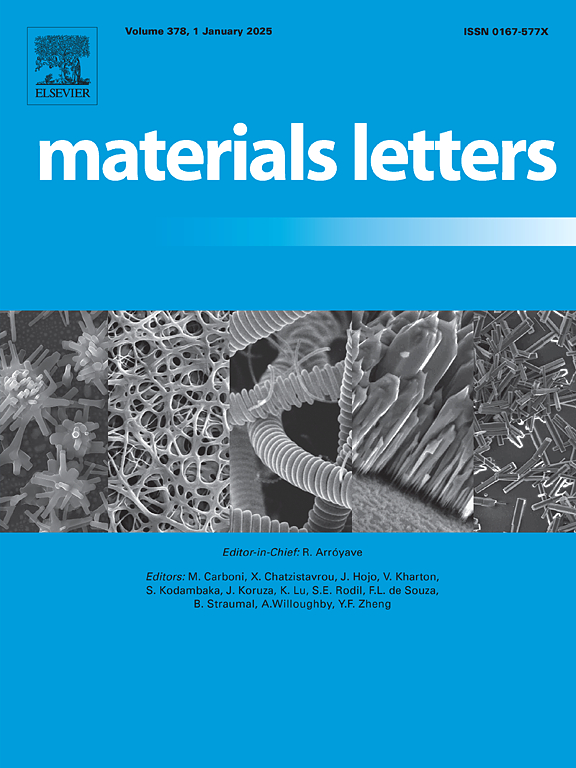Enhanced magnetoelectric response in PVDF/CoFe2O4/Ni films via scalable fabrication and self-aligned β-phase formation
IF 2.7
4区 材料科学
Q3 MATERIALS SCIENCE, MULTIDISCIPLINARY
引用次数: 0
Abstract
Polymer-based magnetoelectric (ME) films have emerged as key materials in the development of next-generation devices due to their unique ability to couple magnetic and electric fields. In this work, we propose an efficient and scalable fabrication method for polymer-based ME sensors, utilizing polyvinylidene fluoride (PVDF), CoFe2O4 (CFO), and nickel (Ni) through spin-coating and bar-casting techniques. The spin-coated CFO layer on Ni foils enhances magnetic susceptibility and promotes the formation of self-aligned β-phases at the CFO/PVDF interface, thereby obviating the need for a conventional electrical poling process. The fabricated ME films, with a high β-phase content of 93.7 %, exhibited a gradient magnetoelectric voltage coefficient (ΔαME) of 14.69 mV/cm·Oe within a DC magnetic field (Hdc) range of −60 to 60 Oe. This pronounced ΔαME response indicates that the ME films are highly sensitive to small magnetic field variations, making them well-suited for applications requiring precise magnetic field detection. The demonstrated sensitivity suggests potential use in the development of advanced magnetoelectric sensors.
PVDF/CoFe2O4/Ni薄膜磁电响应的可扩展制备和自对准β相形成
聚合物基磁电(ME)薄膜由于其独特的耦合磁场和电场的能力,已成为开发下一代器件的关键材料。在这项工作中,我们提出了一种高效、可扩展的聚合物基ME传感器制造方法,利用聚偏氟乙烯(PVDF)、CoFe2O4 (CFO)和镍(Ni),通过旋转涂层和棒铸造技术。Ni箔上的自旋涂覆CFO层提高了磁化率,并促进CFO/PVDF界面上自排列β相的形成,从而避免了传统电极化工艺的需要。制备的ME薄膜β相含量高达93.7%,在−60 ~ 60 Oe的直流磁场(Hdc)范围内,梯度磁电电压系数(ΔαME)为14.69 mV/cm·Oe。这种明显的ΔαME响应表明,ME薄膜对微小的磁场变化高度敏感,使其非常适合需要精确磁场检测的应用。所展示的灵敏度表明在先进磁电传感器的开发中有潜在的用途。
本文章由计算机程序翻译,如有差异,请以英文原文为准。
求助全文
约1分钟内获得全文
求助全文
来源期刊

Materials Letters
工程技术-材料科学:综合
CiteScore
5.60
自引率
3.30%
发文量
1948
审稿时长
50 days
期刊介绍:
Materials Letters has an open access mirror journal Materials Letters: X, sharing the same aims and scope, editorial team, submission system and rigorous peer review.
Materials Letters is dedicated to publishing novel, cutting edge reports of broad interest to the materials community. The journal provides a forum for materials scientists and engineers, physicists, and chemists to rapidly communicate on the most important topics in the field of materials.
Contributions include, but are not limited to, a variety of topics such as:
• Materials - Metals and alloys, amorphous solids, ceramics, composites, polymers, semiconductors
• Applications - Structural, opto-electronic, magnetic, medical, MEMS, sensors, smart
• Characterization - Analytical, microscopy, scanning probes, nanoscopic, optical, electrical, magnetic, acoustic, spectroscopic, diffraction
• Novel Materials - Micro and nanostructures (nanowires, nanotubes, nanoparticles), nanocomposites, thin films, superlattices, quantum dots.
• Processing - Crystal growth, thin film processing, sol-gel processing, mechanical processing, assembly, nanocrystalline processing.
• Properties - Mechanical, magnetic, optical, electrical, ferroelectric, thermal, interfacial, transport, thermodynamic
• Synthesis - Quenching, solid state, solidification, solution synthesis, vapor deposition, high pressure, explosive
 求助内容:
求助内容: 应助结果提醒方式:
应助结果提醒方式:


